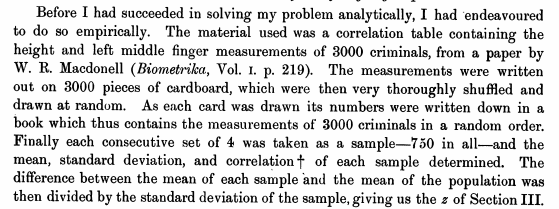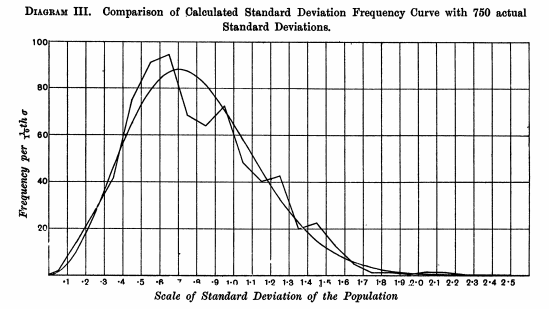Part 2: the t-Distribution
We saw in the previous post that if X is a random variable and the population distribution of X is normal with mean μ and standard deviation σ (variance σ2), then the distribution of the sample mean ˉX for samples of a given size n is normal, with mean μ and standard deviation of σ√n, which we can write ˉXn∼N(μ,σ√n).
Recall that a Z-score is computed Z=ˉX−μσ/√n If you haven’t seen this before, realize that we are just rescaling our sampling distribution from the previous post, ˉX∼N(μ,σ√n), in order to preserve all of the information while setting the mean to 0 and the standard deviation to 1. Another way to think of it is that, instead of dealing in terms of the sample mean ˉX, we want to deal in terms of the distances of the sample mean from the population mean ˉX−μ in units of standard deviation σ, and we can do that by transforming ˉX∼N(μ,σ2/n) into Z=ˉX−μσ/√n.
We can do this because a normal random variable X is still normal when it undergoes a linear transformation (multiplying it, adding to it, etc). This means that if X∼N(μ,σ), then Y=aX+b is also normal, Y∼N(aμ+b,aσ). Using this property,
ˉX−μ∼N(μ−μ,σ√n)=N(0,σ√n)
ˉX−μσ/√n∼N(0σ/√n,σ/√nσ/√n)=N(0,1)
Here’s a quick example just so you can see this in action: the heights (in inches) of adult women in the US are distributed as N(63.8,2.7). Let’s say you, X1, are a 5’8" woman (68 inches tall).
dist<-rnorm(10000,63.8,2.7)
{hist(dist,breaks=100,main="",prob=T)
curve(dnorm(x,63.8,2.7),add=T,col="blue")
abline(v=68,col="red")
text(68,.1,"68")}
# Now we subtract the population mean from every observation in our sample
dist.minus.mean<-dist-63.8
{hist(dist.minus.mean,breaks=100,main="",prob=T)
curve(dnorm(x+63.8,63.8,2.7),add=T,col="blue")
#notice how adding the mean y=f(x+63.8)
abline(v=68-63.8,col="red")
text(4.2,.1,"4.2")}
# See how nothing changed except the x-axis; we have effectively scooted the entire distribution right, so that it is centered at zero. Now let's divide each observation by the population standard deviation$
dist.minus.mean.dividedby.sd<-dist.minus.mean/2.7
{hist(dist.minus.mean.dividedby.sd,breaks=100,main="",prob=T)
curve(dnorm(x,0,1),add=T,col="blue")
abline(v=(68-63.8)/2.7, col="red")
text(2,.3,labels="1.555555")}
I drew a sample of 10,000 from such a distribution just to illustrate how subtracting the mean from each of those 10,000 values and then dividing each by the standard deviation preserves the normality of the sample (see distribution overlayed in blue).
Recall too that, if our statistic is normally distributed, 95% of the density should lie within 1.96 standard deviations of the mean. Here, pnorm is the CDF for the normal distribution: it gives us the area under the curve from −∞ to q, where q is a Z-score.
pnorm(1.96)-pnorm(-1.96)## [1] 0.9500042OK, now back to STUDENT:

Here’s what he means. Let’s take repeated samples of 10 students’ heights and calculate the ˉX and s for each.
samps10<-matrix(nrow=10,ncol=10000)
samps10<-replicate(10000,sample(pop.height,10))
samps.mean<-apply(samps10,2,mean)
samps.sd<-apply(samps10,2,sd)Now, is it really true that, when we substitute s for σ that 95% of the time the true population mean lies within ˉX±1.96∗s/√n?
s10.s<-mean(samps.mean-1.96*samps.sd/sqrt(10)> pop.mean | pop.mean>samps.mean+1.96*samps.sd/sqrt(10))
s10.s## [1] 0.0854Hmm, it looks like the population mean is actually outside this range 8.54% of the time. Clearly, when we do not know σ, we cannot substitute s with impunity. Again, had we known s, things would have been fine:
samps10<-matrix(nrow=10,ncol=10000)
samps10<-replicate(10000,sample(pop.height,10))
samps.mean<-apply(samps10,2,mean)
s10.sigma<-mean(samps.mean-1.96*pop.sd/sqrt(10)> pop.mean | pop.mean>samps.mean+1.96*pop.sd/sqrt(10))
s10.sigma## [1] 0.0466Using the population standard deviation, we find that the population mean falls outside two standard errors of the sample mean just 4.66% of the time. But this is no help to us in the real world!
Things just get worse with smaller samples. Here’s what happens if we just have n=3
samps3<-matrix(nrow=3,ncol=10000)
samps3<-replicate(10000,sample(pop.height,3))
samps3.mean<-apply(samps3,2,mean)
samps3.sd<-apply(samps3,2,sd)
s3.s<-mean(samps3.mean-1.96*samps3.sd/sqrt(3)> pop.mean | pop.mean>samps3.mean+1.96*samps3.sd/sqrt(3))
s3.s## [1] 0.2059Yikes, now the population mean falls outside our 95% confidence interval 20.59% of the time; clearly, assuming normality is inappropriate when samples are small and we are using s instead of σ.
This problem was solved by William Sealy Gosset (“Student”") in 1908, whose paper is excerpted throughout this post

The “alternative” he furnishes is none other than the t distribution.
First, he determines the sampling distribution of standard deviations drawn from a normal population; he finds that this agrees with the Chi-squared distribution
The, he shows that there is no correlation between the sample mean and the sample standard deviation (suggesting that the two random variables are independent).
Finally, he determines the distribution of t (which he calls z), which is the distance between the sample mean and the population mean, divided by the sample standard deviation ˉx−μs/√n (note the n in the denominator instead of our n-1)
First, he shows that
x=(n−1)σ2s2∼χ2n−1, that is, it has the densityp(x|n)=12n−12Γ(n−12)xn−12−1e−x2
Can we confirm this? Recall that our population variance σ2 was 15.5544059, so let’s plot ’em and see if this density fits
#The distribution of sample variance when n=3
n=3
{hist((n-1)/(pop.sd^2)*samps3.sd^2,prob=T,breaks=50)
curve(1/(2^((n-1)/2)*gamma((n-1)/2))*x^((n-1)/2-1)*exp(-x/2),xlim=c(0,30),add=T)
curve(dchisq(x,df=2),add=T)}
#The distribution of the sample variance when n=10
n=10
{hist((n-1)/(pop.sd^2)*samps.sd^2,prob=T,breaks=50)
curve(1/(2^((n-1)/2)*gamma((n-1)/2))*x^((n-1)/2-1)*exp(-x/2),xlim=c(0,30),add=T)
curve(dchisq(x,df=9),add=T)}
Looks pretty good! Finally, he finds the distribution of the distances of the sample mean to the true mean ¯Xn−μ, divided by the standard deviation of the sample mean s/√n (instead of dividing by σ/√n; see previous post).
t=ˉX−μs/√n, which has the densityp(t|n)=Γ(n2)Γ(n−12)1√(n−1)π(1+t2n−1)−n/2
Replacing σ with s in our Z-score formula gives a statistic that follows …you guessed it, the t distribution! The function itself looks way different that the normal density function p(x|μ,σ)=1√2πσe−(x−μ)22σ2. First of all, notice that it doesn’t depend on μ or σ at all; let’s see how it actually looks compared to a normal distirbution
t.pdf<-function(x,n){gamma(n/2)/(sqrt((n-1)*pi)*gamma((n-1)/2))*(1+x^2/(n-1))^(-n/2)}
{curve(t.pdf(x,3),xlim=c(-4,4),ylim=c(0,.4),col="red")
curve(t.pdf(x,4),xlim=c(-4,4),ylim=c(0,.4),col="red",add=T,lty=2)
curve(t.pdf(x,6),xlim=c(-4,4),ylim=c(0,.4),col="red",add=T,lty=3)
curve(t.pdf(x,11),xlim=c(-4,4),ylim=c(0,.4),col="red",add=T,lty=4)
curve(t.pdf(x,26),xlim=c(-4,4),ylim=c(0,.4),col="red",add=T,lty=5)
curve(dnorm(x,0,1),add=T,col="blue")}
Above, we have plotted five t distributions (red) with 2, 3, 5, 10, and 25 degrees of freedom. Notice that the distribution with df=25 is almost indistinguishable from the normal distribution (blue). In fact, though it wasn’t proven until much later, tn→N(0,1) as n→∞
Does this jibe with our observed data better than the normal? Let’s look at our samples of size 3 again and plot their respective t-statistics:
n=3
ts=(samps3.mean-pop.mean)/(samps3.sd/sqrt(n))
{hist(ts,prob=T,breaks=500,xlim=c(-10,10))
curve(dt(x,df=2),add=T,col="red")
curve(dnorm(x,0,samps3.sd[1]/sqrt(n)),add=T,col="blue")}
n=10
ts=(samps.mean-pop.mean)/(samps.sd/sqrt(n))
{hist(ts,prob=T,breaks=50,xlim=c(-5,5))
curve(dt(x,df=9),add=T,col="red")
curve(dnorm(x,0,samps.sd[1]/sqrt(n)),add=T,col="blue")}
Looks much better! Remember how when we assumed that the means of samples of size 3 were normally distributed, our 95% confidence interval (the interval from Z=-1.96 to Z=1.96) only included the mean 79.41% of the time? In a t distribution with n-1 degrees of freedom, 95% of the distribution lies within 4.3 sample standard deviations of the population mean.
qt(c(.025,.975),2)## [1] -4.302653 4.302653x1<-seq(-6,-4.3,len=100)
x2<-seq(4.3,6,len=100)
y1<-dt(x1,2)
y2<-dt(x2,2)
x3<-seq(-6,-1.96,len=100)
x4<-seq(1.96,6,len=100)
y3<-dnorm(x3)
y4<-dnorm(x4)
{curve(dt(x,2), from=-6, to=6,ylim=c(0,.4),col="red")
curve(dnorm(x),from=-6, to=6,add=T,col="blue")
polygon(c(x1[1],x1,x1[100]),c(0,y1,0),col="red",border=NA)
polygon(c(x2[1],x2,x2[100]),c(0,y2,0),col="red",border=NA)
polygon(c(x3[1],x3,x3[100]),c(0,y3,0),col="blue",border=NA)
polygon(c(x4[1],x4,x4[100]),c(0,y4,0),col="blue",border=NA)}
The plot above shows a normal N(0,1) distribution in blue and a t distribution with 2 degrees of freedom in red; note that the red areas under the t add up to 5% and the blue areas under the N(0,1) add up to 5%.
Since the t-statistic t=ˉX−μs/√n follows this distribution, we can rearrange it to find the confidence interval around the population mean.
−t≤ˉX−μs/√n≤t−ts√n≤ˉX−μ≤ts√n−ts√n−ˉX≤−μ≤ts√n−ˉXts√n+ˉX≥μ≥−ts√n+ˉXˉX−ts√n≤μ≤ˉX+ts√n
Lets create 10,000 intervals just like the one above using random draws from our population of heights to find our ˉX and s to see how many times they don’t actually contain the true mean μ. We will use t=4.3 because we saw that if the sample means follow a t-distribution, the 95% of the density should be within ˉX±4.3 sample standard deviations (s/√n) away.
samps3t<-matrix(nrow=3,ncol=10000)
samps3t<-replicate(10000,sample(pop.height,3,replace=T))
samps3t.mean<-apply(samps3t,2,mean)
samps3t.sd<-apply(samps3t,2,sd)
s3t.s<-mean(samps3t.mean-4.303*samps3t.sd/sqrt(3)> pop.mean | pop.mean>samps3t.mean+4.303*samps3t.sd/sqrt(3))
s3t.s## [1] 0.056Yay! Assuming a t-distribution, the population mean falls outside our 95% confidence interval 5.6% of the time; clearly this distribution is a much better fit for a sampling distribution when samples are small and we are using s instead of σ.
#Student’s “Simulations”
Thanks to computers, we can easily check the results of our derivations by using monte carlo sampling techniques. Gosset obviously could not do this. Perhaps the most remarkable thing about his paper, however, is that it does contain one of the earliest simulation studies in history. He did this by hand, with “3000 pieces of cardbord, which were very thoroughly shuffled and drawn out at random.”

Below, he plots the observed distribution of the standard deviations of his samples of size n=4 and overlays his curve:

And here below, he plots his observed distribution of z=ˉX−μs/√n, where his s divides by n instead of n−1,

#Hypothesis Testing with the T-Test
The development of the t distribution was hugely important because it gave the enabled the t-test, commonly used as a location test for the mean. Recall that the t statistic t=ˉX−μσ/√n follows a t-distribution (with n−1 degrees of freedom). Now, given that we have some data, the only unknown here is the parameter μ, the population mean. Let’s generate a null hypothesis: let μ=μ0=0 and n=10; this gives a distribution of the sample mean ˉX for samples of size 10 around a “true” population mean of μ0=0, while accounting for uncertainty in the sample variance. Thus, we can ask how likely we are to observe our sample mean ˉX10, given that the true population mean is actually 0. Let’s do this; we will take a random sample of size from a normal distribution with a mean of 1 and a standard deviation of 1; we will then calculate the mean and ask how likely this value would be if the true mean was actually equal to 0.
tsamp<-rnorm(10,1,1)
tsamp.mean<-mean(tsamp)
tsamp.sd<-sd(tsamp)
tstat<-(tsamp.mean-0)/(tsamp.sd/sqrt(10))
x1<-seq(-5,-2.26,len=100)
x2<-seq(2.26,5,len=100)
x3<-seq(tstat,5,len=100)
x4<-seq(-5,-1*tstat,len=100)
y1<-dt(x1,9); y2<-dt(x2,9); y3<-dt(x3,9);y4<-dt(x4,9)
{curve(dt(x,9),main="",xlim=c(-4,4))
polygon(c(x1[1],x1,x1[100]),c(0,y1,0),col="grey",border=NA)
polygon(c(x2[1],x2,x2[100]),c(0,y2,0),col="grey",border=NA)
polygon(c(x3[1],x3,x3[100]),c(0,y3,0),col="black",border=NA)
polygon(c(x4[1],x4,x4[100]),c(0,y4,0),col="black",border=NA)
abline(v=tstat,lty=2)}
2*(1-pt(tstat,df=9))## [1] 0.02300813The probability of observing a sample mean (i.e., a t statistic) at least this extreme (in either direction!) is .016 (this is the sum of the black areas under the t curve). The area under the curve to the right of our observed statistic is only round(1-pt(tstat,df=9),3), but we have to double it to account for a just as extreme or more extreme observation happening in the other direction. We do this because we didn’t have any a priori hypothesis about the direction of the effect: our default alternative hypothesis was that μ≠0, or prob>|t|=p<−t+p>t where t is our observerd t-statistic tstat. The area shown in gray plus the area in black is equal to 5% of the distribution, 2.5% on each side. This represents the standard “rejection region” with a significance level of 0.05; thus, even if the null hypothesis is true and there is no effect (i.e., μ=0), 5% of the time we would still observe sample means that are at least this extreme: namely, more than t∗(1−α2=.975,n−1=9)=2.262 sample standard deviation away from the true mean.
Assumptions: Independence, Normality, and Equality of Variances
When the t-test is used to compare samples from two populations, the main assumptions that need to be met for this purpose are that the populations are (1) independent of one another, are (2) both normally distributed, and (3) both have the same variance. The first of these can often be fixed using a paired t-test (see below). The second–normality–is usually met in practice thanks to the central limit theorem, but if non-normality is a problem then non-parametric tests such as the Mann-Whitney U test can be used instead. The third–unequal variances–can be tricky, but there are fixes here as well (see Welch’s t-test below).
In order to test for differences between two sample means, we need to find the distribution of ˉX1−ˉX2. For large samples (or when we know the populations are normal), we find that ˉX1−ˉX2 is normally distributed, with a mean of μ1−μ2 and a pooled variance equal to √σ21n1+σ22n2. But when we don’t know σ (which is like, always) and when samples are small (< 30 or so, which is common), this becomes a t-test. Assuming the independence, normality, and equal variance (a.k.a. homoscedasticity) assumptions are met, you would compare two groups with sample means ˉX1,ˉX2, sample standard deviations s1,s2, and sample sizes n1,n2 using the statistic t=ˉX1−ˉX2sp√1n1+1n2, where sp equals
sp=√(n1−1)s21+(n2−1)s22n1+n2−2
Don’t Have Equal Variances? Welch’s
If the assumption of equal variances is violated, you need to use what is often called Welch’s t-test, which uses the test statistic t=¯X1−¯X2√s21n1+s22n2. This formula may look pretty straightforward, but there’s a catch! The degrees of freedom you use are no longer n−1, but are adjusted in the following manner $$ df=
$$
This isn’t too hard to calculate by hand but most software will do it for you. You use the t-distribution with these df rounded down to the nearest whole number. A more conservative, albeit much faster, choice of df is to use the smaller of n−1 and n−2.
Don’t Have Independence? Paired t-Test
If the assumption of independence is violated, it is usually done so on purpose: for example, you may have collected pre-test scores before an intervention, and then afterwards given everyone a post-test. Here, your ˉXpost is dependent on your ˉXpre, since students who had a higher score at pre-test will tend to have higher scores at post-test and vice versa. To get around the issue of dependent data, we use a dependent-samples (or “paired”) t-test. We subtract away any interdependence by calculating n “difference scores” (x1,post−x1,pre,...,xn,post−xn,pre) between the depedent samples (e.g., for each person, subtract their pre-test score from their post-test score). This gets rid of any person-specific effects and leaves of with a bunch of differences, of which we take the mean ˉXD and the sample standard deviation sD before calculating a t-statistic identical to a one-sample t-test: ˉXD−μ0sD/√n. The degrees of freedom, etc., are all just the same as in the one-sample case. Usually, μ0=0 because the null hypothesis is that the means do not differ between time 1 and time 2.
No Normality? Non-Parametrics
Finally, if the assumption of normality is violated, we can use a nonparametric test (a test that, by definition, makes no distributional assumptions). Commonly, the Mann-Whitney U test is used. Here, you calculate a U for each sample by counting up the number of times a given observation xi from one sample is greater than each of the observations in the other sample (counting 0.5 for a tie). The sum of these n counts gives you the U for one sample, and the U for the other is calculated equivalently. Then you can look up the critical value of the U statistic. Interestingly, for n>20 U is approximately normally distributed, with z=U−mUσU, where mU=n1n2/2 and σU=√n1n2(n1+n2+1)12, unless there are lots of ties, in which case a correction exists for the term in the denominator.
No Normality or Independence
In this case, another non-parametric tests can help: the Wilcoxon signed-rank test.
Derivation
He begins by deriving the distribution of the sample standard deviation s for samples of a given size n drawn from a standard normal distribution. If x1,x2,...,xn is one of these samples then, using a property we derived in the previous post, for one sample we have
s2=∑(x2i)n−(∑(xi)n)2=∑(x2i)n−∑(x2i)n2−2∑i<j(xixj)n2
To make a long story short, he realized that the four moments he computed, scaled in this way, corresponded to one of Pearsons equations (which were parametrized withvalues of β1 and β2). Can you find which one? For instance, when n=2, β1=8 and β2=15

STUDENT: “Consequently, a curve of Professor Pearson’s type III maybe expected to fit the distribution of s^2.” The curve in questions is y=Cxpe−γx, where γ=2M2M3=n2μ′2 and p=4β1−1=n−32, thus yielding
y=Cxn−32enx2μ′2
Great, so now we’ve got our sampling distribution for the standard deviation! Recalling that the sampling distribution for the sample mean is just normal—N(μ,σ√n),
y=1√2π(σ/√n)e−x22(σ/√n)2
He says, “now let us suppose x [which, recall, are observations measured as distances from the population mean] is measured in terms of s, i.e. let us find the distribution of z=xs” which gives,
y=s√2π(σ/√n)e−s2z22(σ/√n)2
To be continued (sorry y’all, this is taking me forever)… at this point I want to just do a change of variable and integrate but that’s not how he does it (at least… I don’t think so?)
The normal distribution is more often parameterized with a variance σ2 like so: N(μ,σ2n). However, since this post and the last deal frequently with the standard deviation, I will be using this notation for the duration of the post. Notice that the base-R functions like rnorm(x,mean=0,sd=1) use the standard deviation. In general, it should be clear from context which one is being considered.↩
It was actually derived by Friedrich Helmert about half a century earlier, but such is the way with credting discoveries).↩
